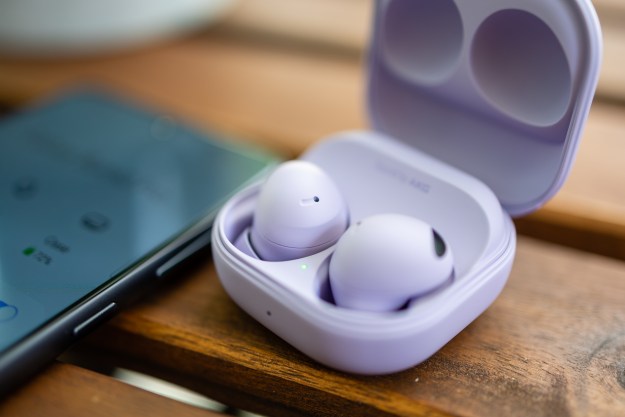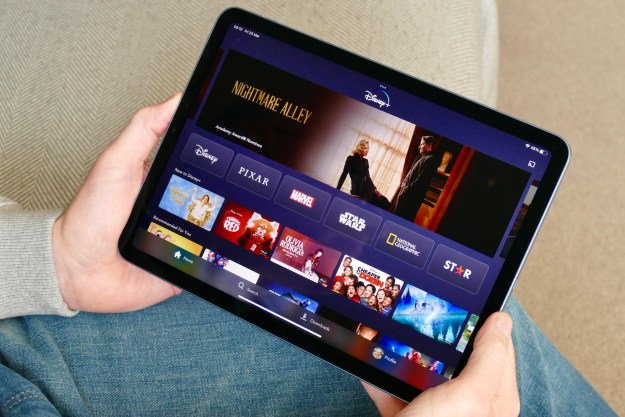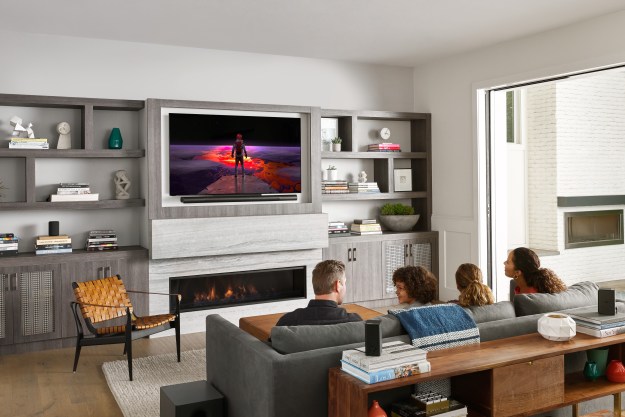The Philips EverPlay series seeks a balance between design and durability, straddling the line between rugged outdoorsiness and classy coffee-table fare. The electronics giant’s newest line of Bluetooth speakers lacks a friendly voice-activated assistant and memorable model names — the various products are called BT3900, BT6900, and BT7900. But it does offer listeners an assortment of affordable options from a reputable brand, each of which boasts excellent wireless range and useful features. We took the mid-level model for a spin, and our Philips EverPlay BT6900 review revealed a nicely balanced speaker.
Unboxed
We’re used to pomp and circumstance when it comes to audio equipment. Many manufacturers splash their packaging with artful renderings of their wireless speaker submerged in water or with vibrant, abstract imaging meant to represent… something. Philips took a different approach, bathing their box in baby blue and making absolutely sure that every feature is prominently listed — over and over again.
The speaker is turquoise, so at least it kinda matches. Frankly, the packaging looks more fit for a baby monitor than a speaker, but we digress.
Features and design
The oval speaker is covered in a mesh-like fabric buffered on either end by rubber caps. One is a sealed hatch concealing the auxiliary and charge ports, while the other is home to the buttons: Power play/pause, volume, and Bluetooth pairing.
The speaker’s battery lasts for about ten hours; this isn’t terrible, but it’s not amazing either.
Rubber feet provide the speaker with solid purchase on most surfaces. Turning it on — one press of the power button does the trick — quickly lights up four LED indicators that represent battery life. Pressing and holding the power button turns on a blue light, but the included instruction sheet (one of those big, dumb fold-out deals) is very confusing and doesn’t properly explain what’s going on. Pressing and holding the Bluetooth symbol makes the blue light flash, which indicates that the speaker is in pairing mode. From here, it’s easy to proceed.
The included charge cable (no wall wart, unfortunately) cleverly doubles as a strap, which lets you hang the speaker from stuff. Unfortunately, it’s a pain in the ass to detach the cable’s ends from its plastic cap; even with untrimmed fingernails, the cap’s design is just frustrating, forcing you to awkwardly press two pens (or other similar tools) together to free the cord.
The speaker is IP57 rated for water- and dustproofing; water doesn’t seem to bother the BT6900 (though we didn’t fully submerge it), but the fabricky weave actually traps dirt, so it’s not a great fit for camping trips or anything like that. We don’t think the dust affected performance, but who wants a dirty speaker?
The speaker’s battery lasts for about ten hours; this isn’t terrible, but it’s not amazing either (it does charge quickly, but it won’t charge your phone for you). What is amazing: The BT6900 boasts a 30-meter Bluetooth range, which is downright ridiculous. You can walk across an entire football field and not lose the connection. Is this a useful feature? Maybe. It seems unlikely that you’d ever need to be so far away from the EverPlay — let us know if you can think of a good use case.
Performance
Listening to music on the EverPlay is a mostly enjoyable experience. The speaker’s sound signature is fairly well balanced, with clear, high treble accentuated by bass that pops (though it doesn’t quite slam). Poppy folk arrangements like Twenty One Pilots’ House of Gold fare well, with bright ukulele and kick drum volleying behind Tyler Joseph’s recognizable vocals. Similarly, more subdued hip-hop tracks sound pretty great — Logic’s Shine On, for one, as the boom-bap beat bounces over an eerie vocal sample to the steady click of drumsticks.
Listening to music on the EverPlay is a mostly enjoyable experience.
Crank up the complexity, however, and the wheels begin to come off. The bass, which comes off punchy in rap music, vanishes entirely in the intro to Massive Attack’s Unfinished Sympathy. Basslines in general are often indiscernible, even at higher volumes, and even when they do sound good, they disappear below the midrange before long (as in The Jakes’ Shake My Hand).
Given the above, we thought the EverPlay would excel with softer, piano-centric compositions. We were wrong. An annoying hiss occupied what should have been empty space in EFFE’s The Forest; the soft tweeting of birds in the song’s early stages sounded garbled, and the “anti-drop” lacked any sort of real impact, instead sounding processed and messy. The same hiss appeared prominently in Nokturn’s cover of Flume’s Never Be Like You, undermining the song’s placid, tranquil vibes.
Taking the BT6900 outside didn’t go particularly well, either. The speaker wasn’t powerful enough to offset the presence of ambient noise — wind, cars on the freeway, etc. — and cranking up the volume only brought distortion. It would probably fit well next to a swimming pool in a secluded backyard, but it won’t win any outdoor awards.
The EverPlay has enough good qualities to earn a spot in your bedroom or living room. It’s fairly stylish without appearing garish, it can survive accidental drink spillage, and it can sound good — if you queue up the right tracks. Unfortunately, at a retail price of $80, we can’t really recommend it. Want a true adventure speaker? Perhaps UE’s Wonderboom would be a good fit. Need better bass and fuller sound? Anker’s SoundCore Boost is a step up in quality without a step up in price. For even more options, consider one of the best Bluetooth speakers under $100.
Editors' Recommendations
- Best Bluetooth speaker deals: Save on Bose, Sonos, JBL, and more
- Sonos likely planning a smaller, cheaper Move portable speaker







